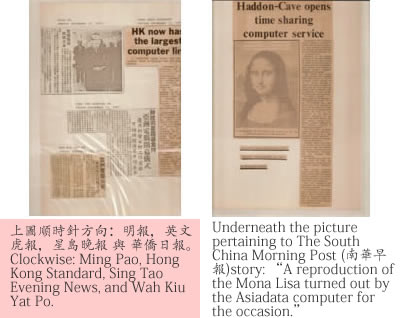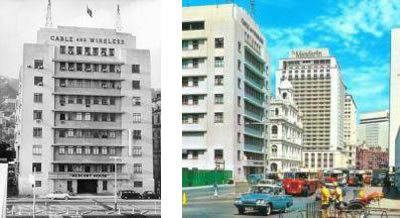
上次約略提到香港舊「麗的呼聲」大廈座落於灣仔海濱告士打道,也談及其後的「亜洲電視」未獲港府續牌,已到窮途末路; 今次講的則是公司名稱相似、有「腦」無「視」的「亜洲電腦」; 「亜視」與「亜電」兩者毫無關係, 但後者則與筆者則好有關係。 我手頭上有些舊剪報, 請閱讀當年的商業新聞報導。
|
亜洲電腦公司 夏鼎基主持開幕禮 ( 特訉 ) 財政師夏鼎基昨日在主持本港第一所供商業用的電腦時間分享服務之公司開幕禮時致詞稱:香港廣泛採用電腦,為經濟發展之一大進步,電腦在本港的工商業中,是一項極備歡迎之發展。 昨日開幕之亜洲電腦有限公司,提供之時間分享服務,使用户在辦公室或廠房內,通過遥遠控制方法,可以直接使用龐大的電腦設備。各類大小商業機構一經採用此種系統,即可簡化日常工作程序。 夏鼎基説:如果要維持經濟上高度的增長率,以獲得物質生活上的享受,便需經常留意各方面効率的增長,這樣一來,便不可忽視運用科學方法分析日常工作所遭遇之困難。 新開幕的電腦公司,乃是採用一副國際電腦公司一九0四A型電腦為中樞。此副儀器重二萬七千磅,佔地面積二千七百平方呎,總值超過八百萬港元。 (崇) |
1971.11.12 華僑日報 (Wah Kiu Yat Po, per bottom left clipping in photo.)
And on the same day, The Hong Kong Standard (英文虎報) covered the story by saying:
“ A computer service bureau with the largest computer facility in Southeast Asia was opened here yesterday…”
As shown in the photos below, the newspaper clippings are 44 years old. Friends in Hong Kong may know that some of these papers have folded many years ago, including Wah Kiu Yat Po (華僑日報); ditto for its two evening editions of Wah Kiu Man Po (華僑晚報), and Sing Tao Evening News (星島晚報). This is because many people, just like you, and friends around the globe, have switched to online reading mode.

Excerpt from South China Morning Post business news, 1971.11.12 (clipping on the right above):
|
Haddon-Cave opens time sharing computer service Hongkong’s first computer service bureau to introduce a remote time sharing system to the entire business community was officially opened yesterday by the Financial Secretary, Mr C.P. Haddon-Cave. Speaking at the opening ceremony of Asiadata Limited, the Financial Secretary praised the newly introduced system as “a most welcome development” and “another step forward to promote greater computer utilization in Hongkong.” … The ICL 1904A computer weighs 27,000 lbs. and covers more than 2,700 sq. ft. fully assembled. Total “hardware”—computer and all its accessories — cost over HK$8 million. Asiadata whose head office is in Jardine House is a joint venture of Cable & Wireless Ltd, Jardine, Matheson and Co Ltd, International Computers Ltd (ICL), and Barclays Bank International… |
The ICL1900 Series computers were 24-bit word machines (supporting four 6-bit characters per word) and using octal for binary short-hand, as opposed to IBM Systems’ using 8-bit bytes and hex. If my memory – of unknown size — serves me correctly, the total memory size of the multi-ton so-called “Small-i” (細-i) ** 1904A system was 64K words at the time I joined Asiadata Limited upon my return to Hong Kong from Canada. ( ** whereas IBM was called “Big-I” (大-I), a school chum who returned to Hong Kong a year earlier than I told me then. He was working for WANG.)
Asiadata had by then relocated from Jardine House to Mercury House on Connaught Road Central. (See photos below.) As Hong Kong’s first and biggest computer service bureau, we served several large companies in the colony, plus many of our UK parent company Cable and Wireless’ (C&W) telecommunication subsidiaries in Bahrain, Dubai, Quata and other cities in the Middle-East. Yes, all the processing was done by that single 64K-word computer, a monster in appearance but was really small inside! (By comparison, today’s iPhone-6 weighs 6.1 oz with 1 GB RAM and internal memory of 16/64/128GB.)
Mercury House was located across the road from the City Hall, where our School choir won championships in consecutive years. Up till the 1970’s, Mercury House was the place where people had to go to in order to make phone calls to overseas or mainland China. It housed Hong Kong’s only long-distance telephone and telegram centre for the public. It was later called Old Mercury House when New Mercury House was built on reclaimed land in Wanchai that was just a stone’s throw from the original site of Rediffuson Building (「麗的呼聲」大廈 ) where my schoolmates and I had recited on live TV broadcast 「車轔轔,馬蕭蕭,行人弓箭各在腰 …」。

互聯網上五十、六十年代的圖片: 右圖由左至右: 水星大廈,香港會所,文華酒店,和較矮、以花崗岩和紅磚建造的香港郵政總局。 干諾道雖然没有馬匹可見, 但也見「車轔轔」… 房車,單層巴士和人力(手拉)車。
(完)
Note: Click here to continue browsing other writings and works of Simon Tam within this site
Simon has a good desription of HK’s IT history. His memory is excellent and supportive with almost 43 plus years old newspaper clips. A good page of HK IT history indeed.
On the other hand, as we read history, we should also think of the status of HK IT today? Dealing with “changes” is the way to survive, will HK IT survive? What is the road map of HK IT? How will HK IT to be competitive to Taiwan, South Korea, Singapore, and Japan? Any more innovative development to uplift HK IT? Yes, HK was the first to start the IT business in Asia, but more and more Asian countries has passed HK IT. History has a way to remind us, provide an indicator for us to compare and contrast.
Thank you, Mr. Lau, you are so kind!
Your first paragraph, as a Chinese saying goes, leaves me no place to hide. However, that “dealing with changes/survival of the most adaptable” is a very good point cannot be denied. That’s why most newspapers have now gone online — in order to keep readers on their side.